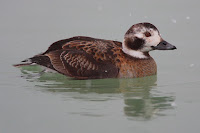LONG-TAILED DUCK
LONG-TAILED DUCK – (Clangula hyemalis) – (See images below)
DESCRIPTION: The Long-tailed Duck is a diving species. This duck has a complicated pattern of plumages, which does not match the breeding and non-breeding seasons. The adult male, as its name implies, has long black tail feathers, almost as long as its body. The black bill is short and has an orange spot in the middle in the non-breeding male, which turns to white in the breeding male. In the breeding male the head is black with a white patch around the eye, the reverse of the non-breeding male. The wings are always black. The under parts are white. Females are brown with white around the head area. Their bill is black. Immature males have a white head and neck with a black patch, and dark back and wings. The length is approximately 50 cm (20 inches).
VOICE: https://www.xeno-canto.org/species/Clangula-hyemalis
NAME: The English name ‘Duck’ is from Anglo-saxon ‘duce’ and means ‘diver’. The Latin name ‘Clangula’ is from Greek and means ‘noise’, and ‘hyemalis’ refers to ‘wintry’.
HABITAT: Both salt water along the ocean coasts and fresh water lakes.
DIET: Plant matter, fish and invertebrates.
NESTING: The nest is placed on the ground near water. About seven dark green eggs are laid, which are incubated by the female. Ducklings can feed themselves but are cared for by the female.
DISTRIBUTION: This duck overall breeding range is in the Arctic around the globe, along coastal areas. It winters along the coasts of Canada, Asia and Europe, and also on the Great Lakes. Some vagrants have been able to reach Hawaii. (See note below on bird vagrancy.)
DISTRIBUTION MAP: https://en.wikipedia.org/wiki/Long-tailed_duck#/media/File:Clangula_hyemalis_map.svg
ON PEI: The long-tailed duck does not breed on Prince Edward Island, but this species is present throughout the year. It is very common in spring, fall and winter, but in the fall its occurrence is occasional only.
CONSERVATION: Although the population of this duck species is difficult to evaluate due to its distribution, it is identified as ‘vulnerable’ due to a ‘precipitous’ decline its population. Some threats include wetland habitat degradation, oil spills and other pollution, and being caught in fishing nets.
NOTES:Long-tailed ducks spend more time under water than on the surface, and can dive to a depth of some 200 meters (600 feet).
Vagrancy: In biology this means an animal going way outside its normal range. For birds, this can happen when there are storms and they get blown off course. On other times, the bird simply wanders in a different direction than usual. Here’s an article about vagrancy in birds.
SIMILAR SPECIES: Northern Pintail
REFERENCES: https://www.borealbirds.org/bird/long-tailed-duck
https://www.allaboutbirds.org/guide/Long-tailed_Duck/id
https://www.audubon.org/field-guide/bird/long-tailed-duck
http://www.ducks.org/hunting/waterfowl-id/long-tailed-duck
https://en.wikipedia.org/wiki/Long-tailed_duck
https://www.rspb.org.uk/birds-and-wildlife/wildlife-guides/bird-a-z/long-tailed-duck
http://www.npolar.no/en/species/long-tailed-duck.html (Norwegian Polar Institute)
DESCRIPTION: The Long-tailed Duck is a diving species. This duck has a complicated pattern of plumages, which does not match the breeding and non-breeding seasons. The adult male, as its name implies, has long black tail feathers, almost as long as its body. The black bill is short and has an orange spot in the middle in the non-breeding male, which turns to white in the breeding male. In the breeding male the head is black with a white patch around the eye, the reverse of the non-breeding male. The wings are always black. The under parts are white. Females are brown with white around the head area. Their bill is black. Immature males have a white head and neck with a black patch, and dark back and wings. The length is approximately 50 cm (20 inches).
VOICE: https://www.xeno-canto.org/species/Clangula-hyemalis
NAME: The English name ‘Duck’ is from Anglo-saxon ‘duce’ and means ‘diver’. The Latin name ‘Clangula’ is from Greek and means ‘noise’, and ‘hyemalis’ refers to ‘wintry’.
HABITAT: Both salt water along the ocean coasts and fresh water lakes.
DIET: Plant matter, fish and invertebrates.
NESTING: The nest is placed on the ground near water. About seven dark green eggs are laid, which are incubated by the female. Ducklings can feed themselves but are cared for by the female.
DISTRIBUTION: This duck overall breeding range is in the Arctic around the globe, along coastal areas. It winters along the coasts of Canada, Asia and Europe, and also on the Great Lakes. Some vagrants have been able to reach Hawaii. (See note below on bird vagrancy.)
DISTRIBUTION MAP: https://en.wikipedia.org/wiki/Long-tailed_duck#/media/File:Clangula_hyemalis_map.svg
ON PEI: The long-tailed duck does not breed on Prince Edward Island, but this species is present throughout the year. It is very common in spring, fall and winter, but in the fall its occurrence is occasional only.
CONSERVATION: Although the population of this duck species is difficult to evaluate due to its distribution, it is identified as ‘vulnerable’ due to a ‘precipitous’ decline its population. Some threats include wetland habitat degradation, oil spills and other pollution, and being caught in fishing nets.
NOTES:Long-tailed ducks spend more time under water than on the surface, and can dive to a depth of some 200 meters (600 feet).
Vagrancy: In biology this means an animal going way outside its normal range. For birds, this can happen when there are storms and they get blown off course. On other times, the bird simply wanders in a different direction than usual. Here’s an article about vagrancy in birds.
SIMILAR SPECIES: Northern Pintail
REFERENCES: https://www.borealbirds.org/bird/long-tailed-duck
https://www.allaboutbirds.org/guide/Long-tailed_Duck/id
https://www.audubon.org/field-guide/bird/long-tailed-duck
http://www.ducks.org/hunting/waterfowl-id/long-tailed-duck
https://en.wikipedia.org/wiki/Long-tailed_duck
https://www.rspb.org.uk/birds-and-wildlife/wildlife-guides/bird-a-z/long-tailed-duck
http://www.npolar.no/en/species/long-tailed-duck.html (Norwegian Polar Institute)
 |
| Long-tailed duck male, nonbreeding plumage, NY - by Wolfgang WAnder |
 |
| Long-tailed duck female, Ontario |